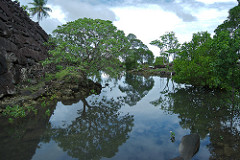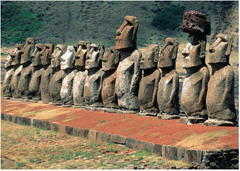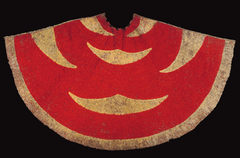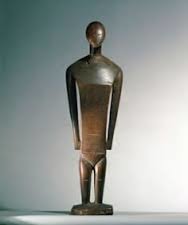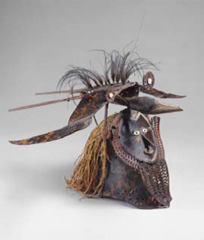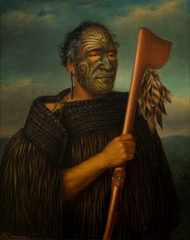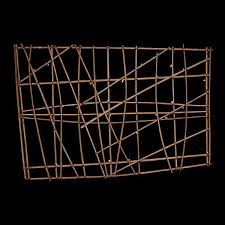Nan Madol. Pohnpei, Micronesia. Saudeleur Dynasty. c. 700-1600 C.E. Basalt boulders and prismatic columns.
Moai on platform (ahu). Rapa Nui (Easter Island). c. 1100-1600 C.E. Volcanic tuff figures on basalt base.
'Ahu 'ula (feather cape). Hawaiian. Late 18th century C.E. Feathers and fiber.
Staff god. Rarotonga, Cook Islands, central Polynesia. Late 18th to early 19th century C.E. Wood, tapa, fiber, and feathers.
N: Staff God
D: late 18th century to early 19th century
A: Unknown
P: Unknown
OL: Rarotonga, Cook Islands, Central Polynesia
M: Wood, Tapa, Fiber, and feathers
T: The carver may have depicted smaller people below the deities to make it seem that they are coming out of him or that he is creating them. This particular staff did not include feathers however, others were believed to have them on the back staff areas.
F: Religious ceremonies (possibly a fisherman's God). It was small in size for the ability to travel with the owner.
C: They were used in worship to their deities, at the beginning of the 19th century Polynesians converted to Christianity suddenly and they were forced to destroy similar wood carvings, very few survived.
DT: Detail oriented
Female deity. Nukuoro, Micronesia. c. 18th to 19th century C.E. Wood.
N: Female Deity
D: 18th to 19th century P/S: Pacific Art
A: unknown
PA: unknown
OL: Nukuoro, Micronesia
M: Wood
T: Carving, these figurines were of smaller statrue and most likey required experice to achieve lines on the Deity.
F: The figurine is known to have been used in religious cerimonies. However the specific type of cerimony is unknown. Some speculation suggest they may have been used in fertility cerimonies.
C: Only 20 left in the world. The Female Deity is shown with many protruding areas from the elbows, shoulders, and breasts. It could be argued that they focused on the functino over the form. Keeping the visual effects simple.
DT: Protudring areas, simple, stiff, rigid
M: wood
height 220 cm
Buk (mask). Torres Strait. Mid- to late 19th century C.E. Turtle shell, wood, fiber, feathers, and shell.
N: Buk (mask)
D: Mid to Late 19th century
P/S: N/A
A: Torres Strait Islander people
Pa: Elders of the Torres strait society
OL: Mabuiag Island, Torres Strait, Australia
M: Turtle shell, wood, fiber, feathers, shell
T: hand-crafted and unique to ceremony
F: Turtle-shell masks in the western Torres Strait reportedly were used during funerary ceremonies and increase rites (rituals designed to ensure bountiful harvests and an abundance of fish and game).
C: The ceremonies often involved performances in which senior men, wearing the masks together with rustling costumes of grass, reenacted events from the lives of culture-heroes, drawn from local oral tradition.
DT: Rough, made of native materials, resembles totem pole
M: This work displays the composite human and animal imagery typical of western Torres Strait masks, and provides insight on the beliefs/religion of the islanders at the time.
Hiapo (tapa). Niue. c. 1850-1900 C.E. Tapa or bark cloth, freehand painting.
N: Hiapo (tapa)
D: 1850-1900 C.E.
P/S: Pacific Art
A: Unknown
P: Unknown
OL: unknown (somewhere in the Pacific islands)
M: Tapa or bark cloth
T: Freehand painting on the cloth. The tribe's people would beat the cloth after weaving to strengthen bonds.
F: The Pacific Islanders were known for wrapping their sacred items in tapa cloths which was unique to their culture. The clothes varied in size and what they protected.
C: In the Islander culture the women's jobs were to weave and beat the Tapa clothes for use.
DT: geometric organization, intricate patterning
M: There is very few remaining authentic Tapa clothes, although they were meant to protect sacred items because few remain they in themselves have become sacred.
Tamati Waka Nene. Gottfried Lindauer. 1890 C.E. Oil on canvas.
N: Tamati Waka Nene
D: 1890 C.E.
P/S: Realism
A: Gottfried Lindaur
Pa: In Lindauer's notebook this portrait is numbered #6 with an inscription saying 'for Mr Partridge'
OL: Ngāti Hao, Ngāpuhi
M: Oil on Canvas
T: Lindauer based this portrait on a photograph by John Crombie who was commissioned to produce 12 photographic portraits of Māori chiefs for the London Illustrated News
F: To commemorate the Maorian chief on being the first of the Pacific islands to join the International trade with England.
C: Tamati Waka Nene lived in the Hokianga when it was a thriving and prosperous trading society and was said to have been an astute businessman and kindly by nature. Nene saw the advantages of having Pākehā shipping traders in the area, and helped settlers as well as Wesleyan missionaries establish themselves there in 1827
DT: smooth brushstrokes, painted to show kind nature of the chief, compassionate, similar portrait style to the Mona Lisa, painted with tribal face paint to reinforce culture
M: to show the Westerners appreciation for the Pacific islanders and their contribution to trading
Navigation chart. Marshall Islands, Micronesia. 19th to early 20th century C.E. Wood and fiber.
N: Navigation Chart
D: 19th century
P/S: N/A
A: Marshall Islands Inhabitants
Pa: unknown
OL: Marshall Islands
M: wooden sticks, cowrie and small shells
T: Rebbelib, a type of navigation chart used to cover a large section of the Marshall Islands.
F: It shows the main pathway between the two main islands, the intersecting lines or areas marked by shells indicate locations of islands while the slopped lines indicate wave swells.
C: The Marshall Islands in eastern Micronesia consist of thirty-four coral atolls spread out across an area of several hundred miles. In order to maintain links between the islands, the Marshall Islanders built seafaring canoes. These vessels were both quick and manoeuvrable. The islanders developed a reputation for navigation between the islands - not a simple matter, since they are all so low that none can be seen from more than a few miles away.
DT: slopped lines that indicate wave swell show technological advancement in society, intricate weaving
M: to direct the natives to islands nearby safely and quickly for trade, by predictin wave swells and the exact locations of islands.
Malagan display and mask. New Ireland Province, Papua New Guinea. c. 20th century C.E. Wood, pigment, fiber, and shell.
N: Malagan display and mask
D: c. 20th Century P/S: Tribal Art/ Ceremonial Art
A: Unknown
Pa: None
OL: New Ireland Province, Papua New Guinea
M: Wood, Pigment, Fiber, and Shell T: Weaving, Figure-making, free-hand painting
F: To serve as visual part of ceremony in which the dead are celebrated and assisted in their transition to the spiritual realm, the ceremonies length can be from months to years so sturdy materials for elaborate structures can withstand long time frame.
C: The culture behind the Malagan display and mask greatly treasure ancestry and the soul/life force of an individual which is what is often portrayed in these displays. They also believe that their loved ones spirits enter into the Malagan so these pieces are treated with the upmost care until they are no longer needed. Once they are no longer needed they are often burned in fear of confusing other spirits trying to find their way.
DT: Natural, mystical, elaborate, large, complex, interwoven, cohesive.
M: These pieces serve to represent the deceased's souls in our world and the ceremonies help to push them on to the spirit world. Also because of the cultures sense of community and familial values we also see it as a way for the entire village to mourn and to publically display the death of a family member. The Malagan, lastly, are very substantial in displaying class because more powerful people were made grander structures and masks.
Processional welcoming Queen Elizabeth II to Tonga with Ngatu launima (tapa cloth). Tonga, central Polynesia. 1953 C.E. Multimedia performance (costume; cosmetics, including scent; chant; movement; and pandanus fiber/hibiscus fiber mats), photographic documentation.
N: Processional Welcoming Queen Elizabeth II to Tonga with Ngatu launima (tapa cloth)
D: 1953 C.E. P/S: Modern Art/ Video Art
A: Unknown
Pa: None
OL: Tonga, Central Polynesia
M: Multimedia performance (costume; cosmetics, including scent; chant; movement; and pandanus fiber/ hibiscus fiber mats), photographic documentation
T: Photography, documentation.
F: To show respect and gratitude towards Queen Elizabeth II for visiting Tonga and for commemorating the war memorial. Also I believe this served as a way of the two countries signaling their alliance and partnership.
C: During both world wars the people of Tonga and England have fought for same cause and have even assisted each other at times so in order to so union between two countries English royal family visits Tonga for the first time and honors those who died in the line of duty.
DT: Elaborate, native, unique, representative, grand-scale, natural
M: The meaning behind the display involves along lasting peace agreement between both queens and Queen Elizabeth's desire to thank those who served, fought, and died in World War II, is what inspirers her arrival. Because it was the first time any English Queen had stepped foot onto the island so it is a celebration of many years of peace and common cause in the war efforts.
